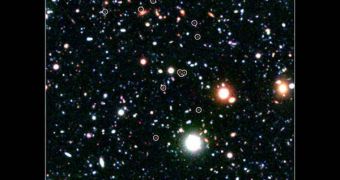Several group of experts operating a multitude of space- and ground-based telescopes managed to peer back into the past, and capture amazing images of a galactic metropolis featuring a multitude of members. Experts believe the structure has since evolved into a modern galaxy cluster.
The reason why this particular collection of galaxies is so important to since is that it's the most distant known in the early Universe. Researchers are looking for such formations in hopes that analyzing them would reveal more insight into how the earliest stars and galaxies appeared and developed.
Experts with the study say that galaxy collection most likely grew into a modern day galaxy cluster, with all the attributes we see in similar formations around our galaxy, the Milky Way.
In order to get the best possible view of the distant “metropolis,” dubbed COSMOS-AzTEC3, astronomers used a number of telescopes, that included some of the most advanced instruments of their type in the world.
NASA made available the Hubble Space Telescope, the Spitzer Infrared Telescope, and the Chandra X-ray Observatory. The ground-based segment of observations was ensured by the W.M. Keck Observatory, and by the Subaru Telescope in Japan.
“This exciting discovery showcases the exceptional science made possible through collaboration among NASA projects and our international partners,” explains NASA official Jon Morse.
The expert is the director of the American space agency's Astrophysics Division, at the NASA Headquarters in Washington DC. He adds that astronomers refer to COSMOS-AzTEC3 as a proto-cluster, and says the structure is some 12.6 billion years old.
This means that it was already in this state when the Universe was 1.1 billion years old. According to experts, this places the time of its development shortly after the reionization epoch, a universal time that was marked by the reionization of the hydrogen atoms that made up all the mass in the Cosmos.
Other versions of proto-clusters, admittedly more mature than this one, have been observed before, but at distances of “only” 10 billion light-years.
“We think the starbursts and black holes are the seeds of the cluster. These seeds will eventually grow into a giant, central galaxy that will dominate the cluster – a trait found in modern-day galaxy clusters,” Peter Capak explains.
The scientists, who is based at the California Institute of Technology (Caltech) Spitzer Science Center , is the first author of a new paper detailing the findings. The work appears in the January 13 issue of the top journal Nature.

 14 DAY TRIAL //
14 DAY TRIAL //